Courtesy: Dominique Hérailh
This data is courtesy of the French Swimming Federation.
The French Swimming Federation has released detailed statistics on all the swimming finals at the Paris Olympics, and in this article, we’ll break down the final of the women’s 200 breaststroke.
- See The Men’s 200 Fly Breakdown Here
- See The Men’s 200 Breast Breakdown Here
- See The Men’s 200 IM Breakdown Here
- See The Men’s 200 Free Breakdown Here
- See The Men’s 400 IM Breakdown Here
- See The Women’s 100 Fly Here
- See The Women’s 200 Fly Here
In this final, a close race was expected between Kate Douglass and Tatjana Smith, the reigning Olympic champion. They were the two favorites coming into the Games, and that expectation was only elevated in the semis when they both went sub-2:20, while the next-fastest swimmer was Tes Schouten at 2:22.74.
Schouten had broken 2:20 earlier in the year, however, and it was these three swimmers who went to battle in the final.
Let’s start by looking at the respective positions of the three medalists throughout the race.
The first 100 meters was close between Douglass and Smith. We’ll go on to see that they were very closely matched down the second 100 as well, though Douglass really pulled away late.
Schouten held second place ahead of Smith, briefly, for about 10 meters, on the back half of the race.
Let’s see how the gaps between the medalists changed throughout the race:
After a good start by Douglass, Smith took the lead until the first turn. Douglass closed the gap in the turn with a faster underwater but was caught by Smith during the swimming portion. This sequence was repeated at every turn and in each split. Schouten kept pace until the 125 meter-mark, and then gradually lost contact with both leaders.
Looking at this graph, the race was determined in the turns and despite Smith’s efforts while swimming, Douglass managed to maintain her lead.
Let’s take a closer look at the race by analyzing the start, turns and the four “over the water” segments.
The Start
Despite a slightly slower reaction time than Smith, Douglass was quicker through 15 meters thanks to a more efficient underwater (14.38m vs 12.38m).
Smith was quicker over the first 15 meters in the 100 breast final than she was here, thanks to a faster underwater (2.54m/s vs 2.44m/s).
At the 15-meter mark, Schouten sat in fourth, behind Kotryna Teterevkova, but took over third by the first turn.
The Turns
Over the three turns, Smith lost a total of 1.37 seconds to Douglass (1.46 if we add the start). Douglass not only went farther underwater, but was faster during the pullouts.
Schouten was also faster than Smith on the turns by 49 one-hundredths, and she was also quicker than Teterevkova (0.61) and Ye Shiwen (-0.17).
“OVER THE WATER” SEGMENTS
In all of the “over the water” segments, Smith swam faster than Douglass. Over the four lengths, the difference was 1.10 seconds in favor of Smith over Douglass and 1.86 seconds comparing Smith to Schouten.
When looking at Schouten in the graph below, note how her decrease in speed is almost linear. If we added a trend line, it would overlap perfectly. Was it a sign that she was going as hard as she could without being able to change her rhythm, or was it the result of pacing her race to optimize her performance?
Ultimately, Douglass was better on the turns, and the difference she had on Smith there was greater than the advantage the South African had in the middle of the pool.
200 Breaststroke Final – First Half Split Checkpoints
| 15 | 25 | 45 | 50 | 65 | 75 | 95 | 100 | |
| K. Douglass | 7.28 | 14.23 | 28.49 | 31.83 | 41.56 | 48.92 | 63.91 | 67.09 |
| T. Smith | 7.37 | 14.12 | 28.19 | 31.60 | 41.78 | 49.12 | 63.85 | 67.21 |
| T. Schouten | 7.45 | 14.43 | 28.69 | 32.07 | 42.13 | 49.36 | 64.11 | 67.57 |
200 Breaststroke Final – Second Half Split Checkpoints
| 115 | 125 | 145 | 150 | 165 | 175 | 195 | 200 | |
| K. Douglass | 77.08 | 84.44 | 99.61 | 102.90 | 112.92 | 120.47 | 135.89 | 139.24 |
| T. Smith | 77.59 | 85.03 | 99.64 | 103.09 | 113.64 | 121.13 | 136.18 | 139.60 |
| T. Schouten | 77.70 | 84.90 | 100.22 | 103.79 | 114.22 | 121.76 | 137.49 | 141.05 |
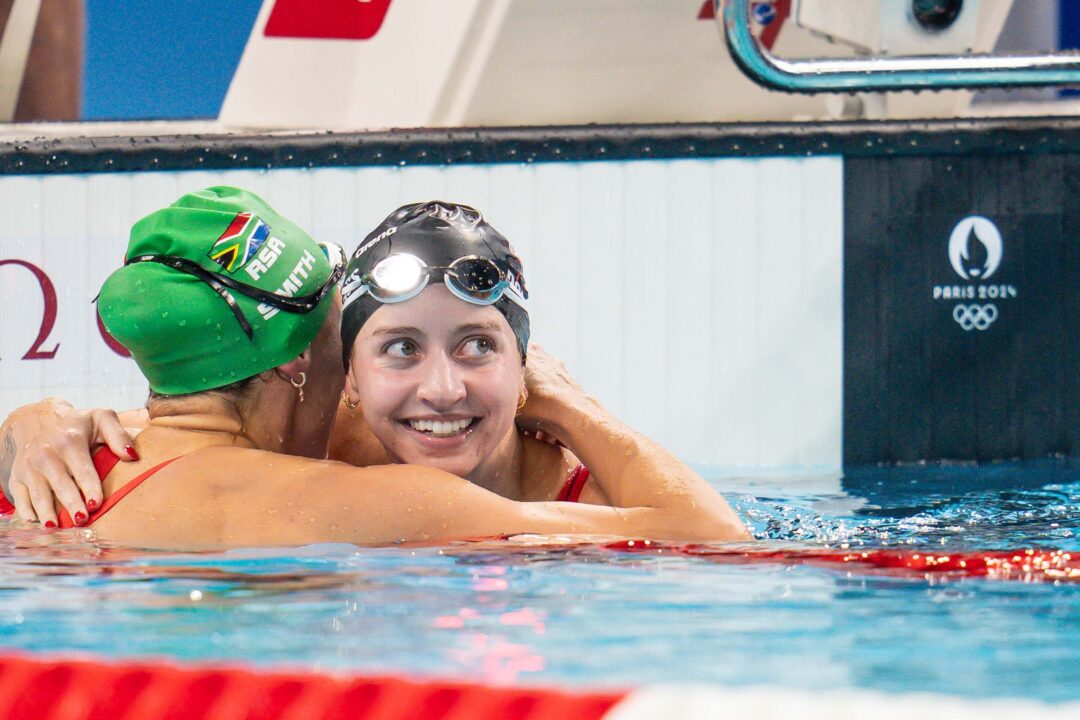
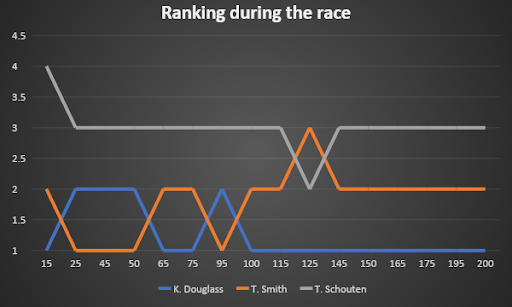
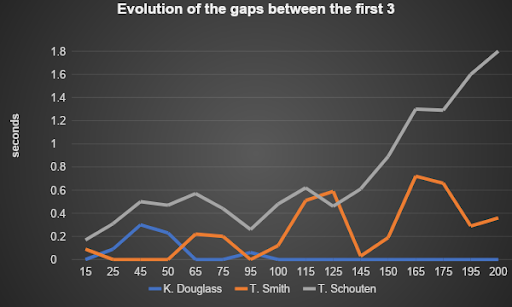
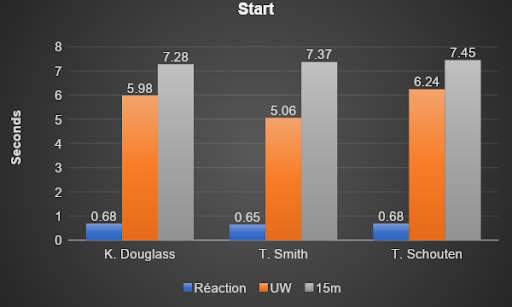
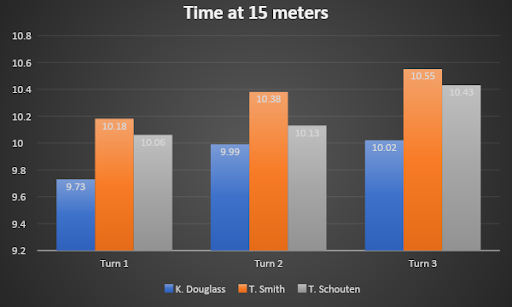
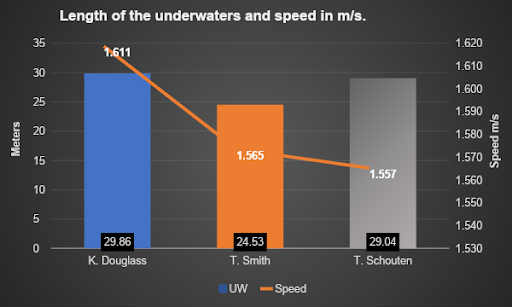
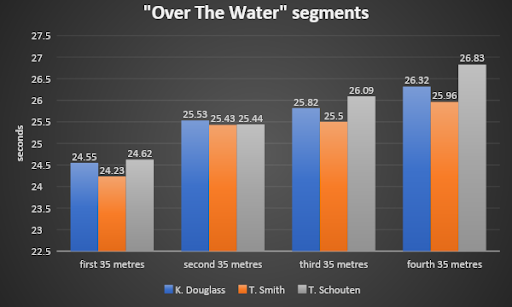
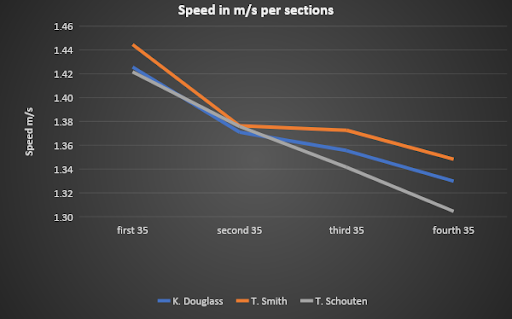
Unless I am mistaken, didn’t she publish a paper on this and the aerodynamics under water with Prof Ken Ono at UV? Talking about getting it down to an exact science!!
Yes – co-authored with Ono, his assistants, and another UVA swimmer, August Lamb
Mathematical Intelligencer
https://link.springer.com/article/10.1007/s00283-024-10339-0
hydrodynamics
Being a world-class butterflier would seem to help, too.
Even if the kick just gives her another tenth or two advantage off each wall…
This is where swimming in the “bathtub” can help us, kids!
its almost as if the “bathtub” didn’t actually destroy her career. funny how that works.
golly gee, if only KD could be as successful as the Australian breaststrokers
I can’t wait to see her in the world cup, it’s definitely the competition for swimmers as versatile as she is.
Pullout goddess
🤨🧐
Also, did great in freestyle on relays and 2nd place in IM.
Douglas has a really unique underwater for breastroke. Ive never seen her technique used effectivley by anyone else.
Leon Freakchand
Can you describe the difference?
She doesnt recover her arms tight and close to her body, but out and around after the pull down. It is quite counterintuitive. There’s pictures online that show it well.